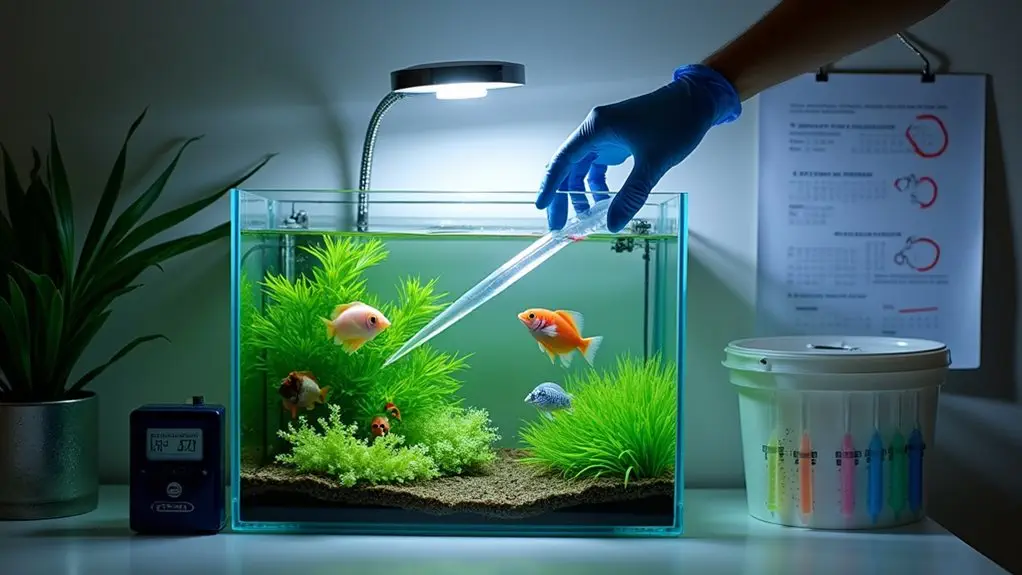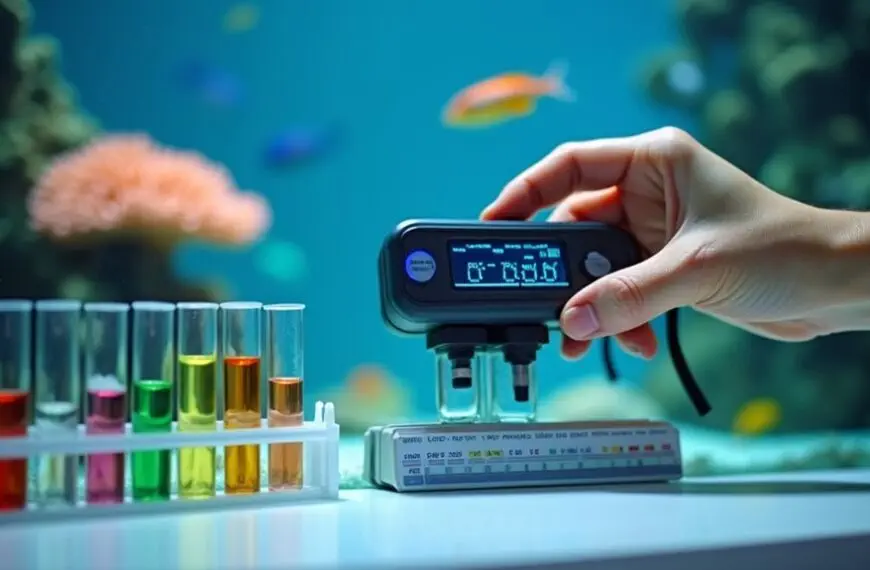Regular water changes are essential for your aquarium's health. Follow these rules: establish a schedule based on tank size, test water parameters first, match new water's temperature and chemistry, never change more than 50% at once, vacuum substrate thoroughly, inspect fish and plants, maintain your filter during changes, and document everything. Use proper cleaning tools (no soap!), and remember that small, consistent changes are better than infrequent large ones. These proven practices will transform your aquarium maintenance routine.
Contents
- 1 10 Rules for Your Aquarium Water Change Schedule
- 2 Establish a Regular Schedule Based on Tank Size
- 3 Test Water Parameters Before Each Change
- 4 Match Temperature and Chemistry of New Water
- 5 Never Change More Than 50% at Once
- 6 Clean Equipment Without Using Soap
- 7 Vacuum the Substrate Thoroughly
- 8 Inspect Fish and Plants During Water Changes
- 9 Maintain Your Filter While Changing Water
- 10 Document Changes and Tank Responses
- 11 Frequently Asked Questions
- 12 Final Thoughts
10 Rules for Your Aquarium Water Change Schedule
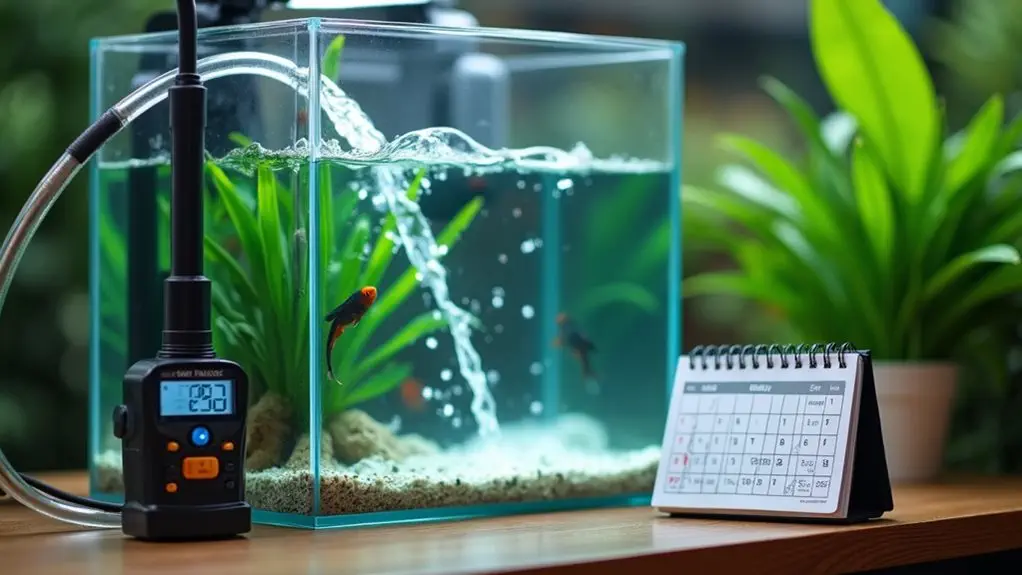
While many hobbyists search for hard-and-fast rules about water changes, the truth is that there's no one-size-fits-all schedule for every aquarium. Your specific setup, fish population, and filtration system all influence how often you'll need to refresh that water.
Instead of focusing on rigid schedules, pay attention to water quality indicators. Test regularly for ammonia, nitrites, and nitrates—these are your best guides. When nitrates climb above 20-40 ppm, it's definitely time for a change.
Let test results—not calendars—dictate your water change schedule. Your fish will thank you.
Fish health is your ultimate indicator. If your finned friends are swimming energetically, eating well, and sporting vibrant colors, you're likely on the right track.
But if they're gasping at the surface or looking dull, you might need more frequent water changes. Keeping an eye on nitrate levels can help you determine when it's best to refresh your aquarium water.
Establish a Regular Schedule Based on Tank Size
You'll need to adjust your water change frequency based on your tank's size, with smaller tanks requiring weekly refreshes, medium-sized aquariums needing bi-weekly attention, and larger setups allowing for monthly maintenance. Your tank's volume directly impacts how quickly waste accumulates and water parameters shift, making smaller environments more vulnerable to rapid changes. Maintaining a consistent monitoring of water parameters helps ensure a healthy aquatic environment.
Weekly for Small Tanks
Small tanks under 20 gallons require weekly water changes of 10-25% to maintain ideal conditions for your aquatic friends.
These smaller environments accumulate toxins faster, making frequent maintenance absolutely essential. You'll notice your fish are more active and colorful when you stick to this schedule.
Mark your calendar or set a phone reminder for your weekly water duty. It's not just about removing waste—you're replenishing minerals and maintaining stable pH levels too.
One of the best small tank tips is to invest in a gravel vacuum siphon to clean substrate while changing water.
Don't skip weeks! Even if your tank looks crystal clear, invisible ammonia and nitrates could be building up. Regular testing of ammonia levels is essential to ensure a healthy environment for your fish.
Your finned companions can't tell you when water quality drops, but their health depends on your consistency.
Bi-Weekly for Medium Size
Medium-sized tanks (20-40 gallons) typically benefit from a bi-weekly water change schedule of 15-20%. This schedule strikes the perfect balance between maintenance needs and your valuable time. Your fish will thank you for the consistent care!
When you maintain this bi-weekly rhythm, you'll notice improved water quality and enhanced fish health. The larger water volume in medium tanks provides a bit more stability than smaller aquariums, giving you a little breathing room between changes. Additionally, regular monitoring of pH is crucial to ensure your fish thrive in a suitable environment.
Don't forget to test your water parameters regularly, even with this schedule. If you notice any spikes in ammonia or nitrites, you might need to adjust temporarily.
Monthly for Larger Volumes
Contrary to popular belief, larger aquariums (50+ gallons) don't require less maintenance—they simply follow a different rhythm.
Your monthly water change routine for these tanks strikes the ideal balance between stability and cleanliness.
With larger volumes, water chemistry remains more stable between changes, giving you some breathing room. Plan to replace 25-30% of the water each month, and you'll keep your aquatic friends happy without disrupting their environment too drastically.
During your monthly ritual, don't forget to check filter media and clean it if necessary. This schedule supports optimal fish health while respecting the established biological balance in your tank. Regular water quality testing is crucial to prevent toxic buildup and maintain a healthy ecosystem.
Think of it as giving your underwater world a refresh rather than a complete overhaul—just enough intervention to maintain that crystal-clear water your fish deserve.
Test Water Parameters Before Each Change
Before rushing into your water change, you'll need to test key parameters like ammonia, nitrite, nitrate, pH, and hardness to understand what's actually happening in your tank.
Your testing kit should include liquid reagents rather than strips for accuracy, with the API Master Test Kit being a popular choice among hobbyists.
These test results will guide how much water you should change, helping you maintain the delicate balance that keeps your aquatic friends healthy and thriving. Regular testing ensures stable living conditions, which are vital for promoting fish health and longevity.
Key Parameters To Track
Four critical water parameters require your attention before performing any aquarium water change.
Monitoring these values isn't just busywork—it's essential for maintaining water quality and ensuring your fish health remains ideal. You'll save yourself countless headaches (and potentially some fishy funerals) by staying on top of these measurements.
Track these parameters religiously:
- Ammonia levels – Should always read zero in an established tank
- Nitrite levels – Also needs to be zero for safe fish habitat
- Nitrate levels – Keep below 20-40ppm depending on your fish species
- pH level – Maintain stability within the appropriate range for your specific fish
Additionally, monitoring the nitrogen cycle is crucial as it influences ammonia and nitrite levels, which directly affect fish health.
Don't skip testing even when you're in a rush—it's the equivalent of checking your car's oil before a long trip!
Testing Kit Essentials
Your essential supplies should include a master test kit that measures ammonia, nitrite, nitrate, and pH at minimum. Don't skimp here—budget kits often give inaccurate readings that could endanger your aquatic pals.
For saltwater tanks, you'll also need calcium and alkalinity tests.
Testing techniques matter just as much as the kit itself. Always rinse test tubes between uses, follow timing instructions precisely, and read results in natural light when possible. You'll get the hang of interpreting those color charts quickly!
Remember to test before each water change—it's like checking your map before taking a journey. Regular testing is vital for early detection of water quality issues to prevent toxicity.
Match Temperature and Chemistry of New Water

When adding fresh water to your aquarium, matching the temperature and chemistry of the new water with your existing tank water is absolutely vital. Your fish friends can experience serious shock if you skip this key step!
Temperature matching prevents stress on your aquatic pets, while chemistry balancing guarantees their environment remains stable.
Here's how to match new water properly:
- Use a reliable thermometer to confirm new water is within 2°F of your tank water.
- Let tap water sit for 24 hours to dissipate chlorine, or use a quality dechlorinator.
- Test both the new water and tank water with your test kit to compare parameters.
- Adjust pH, hardness, and other chemistry values in the new water before adding. Additionally, ensure that the total chlorine levels of the new water are at 0 ppm to protect gill health and prevent further stress on your fish.
Never Change More Than 50% at Once
When changing your aquarium water, you'll want to keep it under 50% to avoid shocking your fish with sudden environmental shifts.
Your tank's ecosystem relies on beneficial bacteria that live in the substrate and filter media, which help break down harmful waste products. By limiting water changes to less than half the total volume, you're preserving enough of these microscopic helpers while still removing accumulated toxins. Regular testing of ammonia and nitrite levels ensures that your fish remain healthy during the water change process.
Avoid Shock to Fish
Although many aquarists believe you shouldn't change more than 50% of your tank's water at once, this isn't always true.
What's most important is preventing shock to your fish, which depends more on maintaining water stability than following rigid percentage rules. Your finned friends can actually handle larger water changes if you're careful about matching conditions.
To avoid fish stress during water changes:
- Match the temperature of new water to within 2-3 degrees of tank water
- Use a water conditioner to neutralize chlorine and heavy metals
- Introduce new water slowly, especially in smaller tanks
- Monitor your fish for signs of stress like darting or hiding
Preserve Beneficial Bacteria
Despite popular belief, the "never change more than 50% at once" rule isn't about preserving beneficial bacteria at all.
These helpful microorganisms live primarily in your filter media and substrate, not swimming freely in your tank water. When you're removing water, you're not greatly reducing your bacteria health.
The real reason for this guideline is to maintain water parameter stability. Massive water changes can shock your fish by suddenly altering temperature, pH, and mineral content.
Your aquatic ecosystem thrives on consistency, not dramatic shifts!
Think of your tank as a delicate balance—small, regular changes keep everything humming along nicely.
Your fish will thank you for the gentle approach, and you'll avoid those panicked moments watching your finned friends react poorly to their suddenly transformed home.
Consistent, smaller changes are always your best bet!
Clean Equipment Without Using Soap
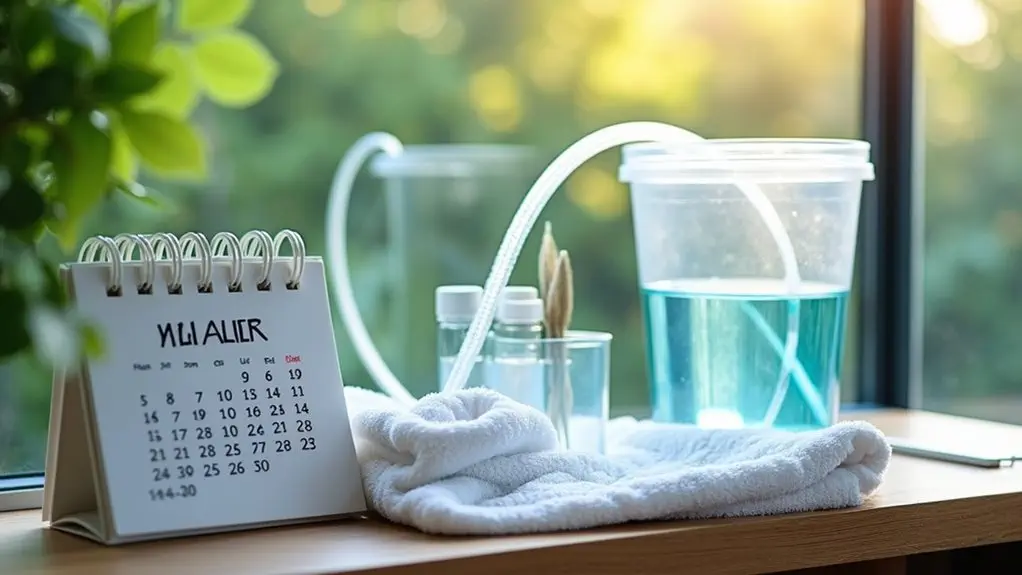
Keeping your aquarium equipment clean is essential for maintaining a healthy tank, but you'll want to avoid using soap at all costs. Even a tiny residue of soap can harm your fish and destroy the delicate biological balance you've worked so hard to maintain.
Instead, try these effective cleaning techniques that won't put your underwater friends at risk:
- Use white vinegar for removing mineral deposits and stubborn algae from glass and plastic components.
- Rinse filter media in old tank water to preserve beneficial bacteria while removing debris.
- Keep a dedicated bucket and brushes for aquarium maintenance tips to prevent cross-contamination.
- Soak equipment in a hydrogen peroxide solution (1 part peroxide to 10 parts water) for tough stains.
Your fish will thank you for these soap-free cleaning methods!
Vacuum the Substrate Thoroughly
When you're performing a water change, properly vacuuming the substrate represents one of the most essential steps in maintaining a healthy aquarium. Your tank's bottom layer collects fish waste, uneaten food, and plant debris that can seriously affect your water quality and substrate health if left unattended.
Start at one corner of the tank and work your way across in a systematic pattern. Hold your vacuum about half an inch above the substrate to capture debris without disturbing beneficial bacteria.
Be methodical and gentle—vacuum half an inch above substrate to remove waste while protecting your tank's beneficial bacteria.
For gravel, you'll want to gently push the vacuum tip into the substrate to release trapped waste, while sand requires a gentler hovering technique to avoid sucking up too much material.
Don't rush this process! Taking your time with proper vacuum techniques guarantees you're removing harmful compounds while preserving the good stuff your aquatic friends need.
Inspect Fish and Plants During Water Changes
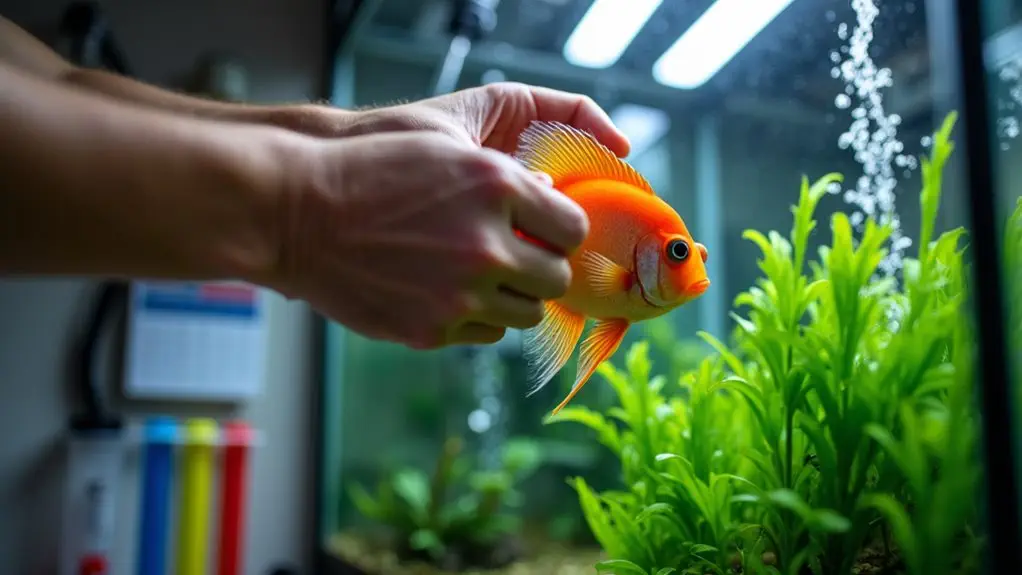
Since water changes provide a perfect opportunity to observe your aquarium's inhabitants up close, you shouldn't miss this chance to inspect your fish and plants thoroughly.
While your finned friends are more active during this invigorating process, you'll get valuable insights into their fish behavior and overall plant health.
Make the most of this observation window by checking:
- Swimming patterns – look for changes that might indicate stress or illness
- Physical appearance – examine fins, scales, and coloration for abnormalities
- Plant root systems – verify they're firmly anchored with healthy white roots
- Leaf condition – inspect for holes, discoloration, or algae buildup
You'll become a better aquarist by developing this inspection habit.
It's like giving your underwater world a mini health checkup each time you renew their environment!
Maintain Your Filter While Changing Water
While observing your aquatic pets provides valuable insights, your filter system deserves just as much attention during water changes. Your filter is the heart of your tank's ecosystem, working tirelessly to maintain water quality, so don't ignore it during maintenance routines!
When changing water, take a moment to check your filter media. Is it clogged with debris? Give it a gentle rinse in the water you've just removed from the tank—never use tap water, as it'll kill beneficial bacteria.
You don't need to clean it spotless; a little gunk actually helps your biological filtration.
Document Changes and Tank Responses
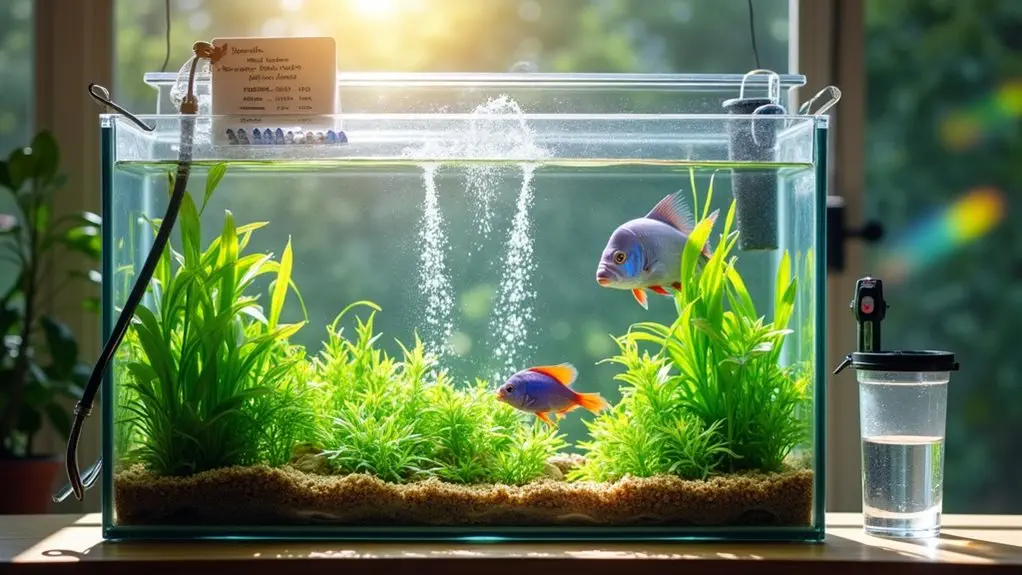
After completing each water change, you'll want to record what you've done and how your tank responds. Keeping detailed notes helps you track patterns in tank health and spot potential issues before they become serious problems. Your aquarium log becomes a valuable resource over time.
Here's what to document after each water change:
- Amount of water changed and any treatments added
- Water clarity before and after the change
- Fish behavior and appearance following maintenance
- Any unusual observations (algae growth, equipment issues)
You'll soon notice correlations between your maintenance routine and overall tank health. Maybe you'll discover that 30% changes yield better water clarity than 15% changes.
These insights are gold! Don't trust your memory—your future self will thank you for keeping these records.
Frequently Asked Questions
Can I Use Distilled Water for My Aquarium Changes?
You can use distilled water, which benefits your aquarium by removing harmful chemicals. However, it lacks essential minerals your fish need. It's better to mix it with tap water or add mineral supplements.
How Do I Acclimate New Fish During Water Change Days?
Ever wondered if fish feel stressed during acclimation? They do! You'll want to float the bag, gradually add tank water every 10 minutes, and wait 30-45 minutes before releasing your new fish to minimize acclimation stress.
Should Water Changes Differ for Saltwater Versus Freshwater Tanks?
Yes, they differ greatly. Saltwater tanks need smaller, more frequent changes (10-15%) due to salt concentration considerations. Freshwater tanks can handle larger changes (25-30%) based on your specific freshwater needs and bioload.
Can Power Outages Impact My Water Change Schedule?
Yes, power outages can disrupt your water change schedule. After power restoration, test your water quality immediately as filtration stoppage causes toxin buildup. You'll likely need to perform an extra water change sooner than planned.
How Do Medications Affect the Timing of Water Changes?
Like a delicate dance, medications affect your water change timing dramatically. You'll need to follow dosage timing instructions precisely, as most medication types require a specific period without water changes to work effectively.
Final Thoughts
You'll find that consistent water changes are like brushing your teeth—skip them, and problems multiply fast. By following these ten simple rules, you're giving your underwater friends the best chance to thrive. Remember when my neglected tank turned into a cloudy mess after just two weeks? Don't make that mistake! Stick to your schedule, keep good records, and you'll enjoy a vibrant, healthy aquarium for years to come.

